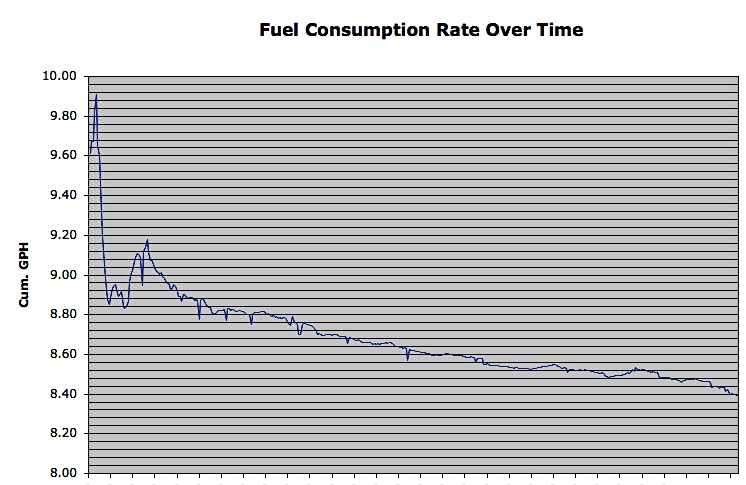n5lp
fugio ergo sum

Since my airplane has been flying I have kept a running total of how many gallons of fuel I have burned. This allows me to see the average fuel consumption over the life of the airplane. I think it is interesting, but it probably says more about me and my changing attitudes over time than it does about the airplane. I have an RV-6 with O-360, carburetor and fixed pitch Sensenich prop and I have burned nothing but 100 octane low lead avgas. The chart covers about 11 1/2 years and 1100 hours of actual in flight time; no ground time.
Some things are obvious, like the high consumption at the beginning during break-in. The dip before it spikes up again may have been during the flight test phase. After that it still stays high for quite a while. The main reason is that I was flying around with my hair on fire. The speed was intoxicating after my old Piper Pacer and I used it. I probably typically cruised at 170 knots or so.
Over time I relaxed some. I found I could dial it back to cruise 155 to 165 knots, depending on the distance and the hurry, and get there almost as fast with better economy and lower sound levels.
Several years ago I made a major operational change in that I started leaning so as to stay around 400 F degrees cylinder head temperature in the climb. I thought this would cause a major uptick in overall fuel consumption but it doesn't really seem to show, so I am glad that I decided to do that. Even though I used to allow the cylinder head temperatures to get around 430 or a bit higher at times, I have had no cylinder problems of any kind unlike the Pacer where the engine would swallow valves and such routinely. Who knows what the temperatures were with that airplane?
All this aside a steady reduction is obvious over time. I think the major reason for that is that I make many more touring local flights now than I once did. When I am taking in the sights it is just nicer to slow down even more. I made a two hour flight yesterday where 80 percent of the time I was indicating around 110 knots looking for the old Butterfield Stage Route with a friend. When it was time to head home we climbed to 9,500 feet and dialed it up to 170 knots and got home quick from 100 miles out.
It is still real nice to have the speed when you want or need it but it isn't necessary to use it all the time to really enjoy the airplane.




